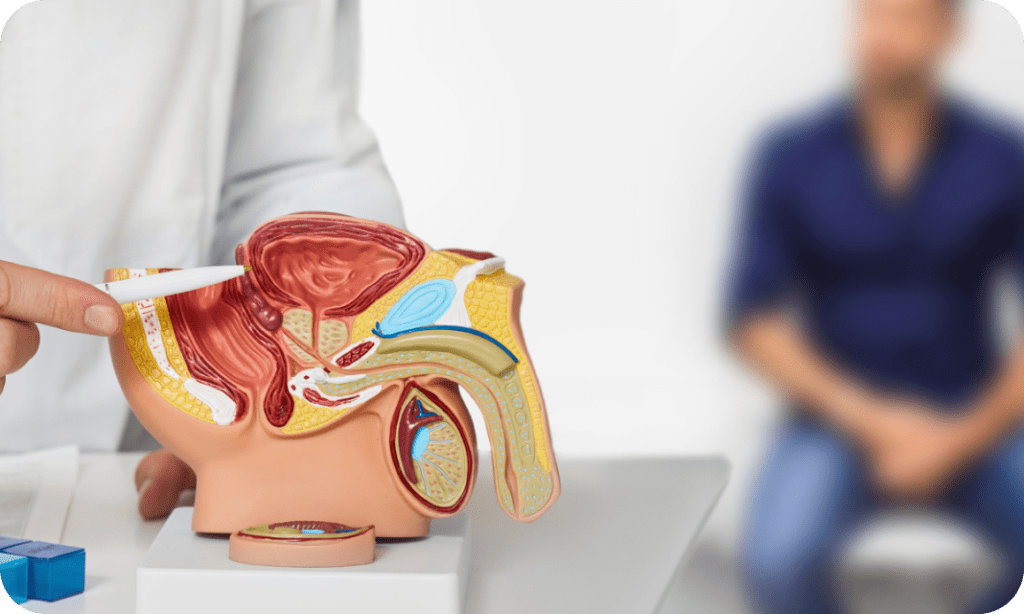A renal cyst is a fluid-filled sac that forms in or on the kidneys. Renal cysts are relatively common and can vary in size and type. In most cases, renal cysts are benign (non-cancerous) and do not cause symptoms, but in some instances, they can lead to complications like pain or infection. The majority of renal cysts are discovered incidentally during imaging tests done for other reasons.

Renal Cyst
Detailed Information
1. Simple Renal Cysts:
o These are the most common type of renal cyst. They are typically round or oval, filled with clear fluid, and have a thin wall. Simple renal cysts usually do not cause symptoms and are often discovered during imaging tests like ultrasound, CT scans, or MRIs.
o Characteristics:
Fluid-filled sac.
Smooth, thin walls.
No solid components or irregularities.
Generally asymptomatic and require no treatment.
2. Complex Renal Cysts:
o These cysts are more unusual and can have solid areas, internal septations (partitions), or irregular walls. Complex cysts may require further evaluation, as they have a higher likelihood of being associated with kidney diseases or even cancer, though they are still usually benign.
o Characteristics:
May contain solid elements or internal septa.
Can be irregular in shape and have thicker, more irregular walls.
May require further imaging or biopsy to rule out malignancy.
3. Polycystic Kidney Disease (PKD):
o Polycystic kidney disease is a genetic disorder in which numerous cysts develop in both kidneys, leading to kidney enlargement and potential kidney function impairment over time. There are two main types:
Autosomal Dominant PKD (ADPKD): The most common form, typically developing in adulthood and often leading to kidney failure.
Autosomal Recessive PKD (ARPKD): A rarer form, usually presenting in infancy or early childhood.
o This condition often leads to renal failure and may require dialysis or a kidney transplant.
4. Acquired Renal Cysts:
o These cysts can develop in individuals who have kidney problems such as chronic kidney disease (CKD) or dialysis-dependent patients. While most of these cysts are benign, there is an increased risk of complications like infection or bleeding, especially in patients on dialysis.
o These are the most common type of renal cyst. They are typically round or oval, filled with clear fluid, and have a thin wall. Simple renal cysts usually do not cause symptoms and are often discovered during imaging tests like ultrasound, CT scans, or MRIs.
o Characteristics:
Fluid-filled sac.
Smooth, thin walls.
No solid components or irregularities.
Generally asymptomatic and require no treatment.
2. Complex Renal Cysts:
o These cysts are more unusual and can have solid areas, internal septations (partitions), or irregular walls. Complex cysts may require further evaluation, as they have a higher likelihood of being associated with kidney diseases or even cancer, though they are still usually benign.
o Characteristics:
May contain solid elements or internal septa.
Can be irregular in shape and have thicker, more irregular walls.
May require further imaging or biopsy to rule out malignancy.
3. Polycystic Kidney Disease (PKD):
o Polycystic kidney disease is a genetic disorder in which numerous cysts develop in both kidneys, leading to kidney enlargement and potential kidney function impairment over time. There are two main types:
Autosomal Dominant PKD (ADPKD): The most common form, typically developing in adulthood and often leading to kidney failure.
Autosomal Recessive PKD (ARPKD): A rarer form, usually presenting in infancy or early childhood.
o This condition often leads to renal failure and may require dialysis or a kidney transplant.
4. Acquired Renal Cysts:
o These cysts can develop in individuals who have kidney problems such as chronic kidney disease (CKD) or dialysis-dependent patients. While most of these cysts are benign, there is an increased risk of complications like infection or bleeding, especially in patients on dialysis.
The exact cause of simple renal cysts is not always known, but several factors can contribute to their formation:
1. Aging: Renal cysts become more common with age. Most people over 50 years old have at least one renal cyst.
2. Genetics: In some cases, genetic conditions such as polycystic kidney disease (PKD) cause the formation of multiple cysts.
3. Chronic Kidney Disease: Acquired cysts can form in people with long-term kidney problems, especially in those on dialysis.
4. Injury or Blockage: Sometimes, a cyst can form as a result of an injury or blockage in the kidney’s filtration system.
1. Aging: Renal cysts become more common with age. Most people over 50 years old have at least one renal cyst.
2. Genetics: In some cases, genetic conditions such as polycystic kidney disease (PKD) cause the formation of multiple cysts.
3. Chronic Kidney Disease: Acquired cysts can form in people with long-term kidney problems, especially in those on dialysis.
4. Injury or Blockage: Sometimes, a cyst can form as a result of an injury or blockage in the kidney’s filtration system.
Most renal cysts do not cause symptoms and are discovered incidentally. However, when symptoms do occur, they may include:
1. Pain:
o Pain or discomfort in the back or sides (flank pain) is one of the most common symptoms when a cyst grows large enough to put pressure on surrounding tissues or organs.
o The pain may be dull or sharp and may be intermittent or constant.
2. Hematuria (Blood in the Urine):
o A cyst that bursts or becomes infected may cause blood to appear in the urine. This can be visible (gross hematuria) or detected through microscopic examination.
3. Infection:
o If a renal cyst becomes infected, it can lead to fever, pain, and tenderness in the abdomen or back. In some cases, the infection may lead to a kidney abscess.
4. High Blood Pressure:
o Large cysts, especially in cases of polycystic kidney disease (PKD), can affect kidney function and lead to hypertension (high blood pressure).
5. Urinary Tract Infections (UTIs):
o People with large or multiple cysts may be more prone to urinary tract infections (UTIs).
6. Enlarged Kidneys:
o In cases of polycystic kidney disease (PKD) or other conditions causing multiple cysts, the kidneys may become enlarged, which can cause a sense of fullness or discomfort.
1. Pain:
o Pain or discomfort in the back or sides (flank pain) is one of the most common symptoms when a cyst grows large enough to put pressure on surrounding tissues or organs.
o The pain may be dull or sharp and may be intermittent or constant.
2. Hematuria (Blood in the Urine):
o A cyst that bursts or becomes infected may cause blood to appear in the urine. This can be visible (gross hematuria) or detected through microscopic examination.
3. Infection:
o If a renal cyst becomes infected, it can lead to fever, pain, and tenderness in the abdomen or back. In some cases, the infection may lead to a kidney abscess.
4. High Blood Pressure:
o Large cysts, especially in cases of polycystic kidney disease (PKD), can affect kidney function and lead to hypertension (high blood pressure).
5. Urinary Tract Infections (UTIs):
o People with large or multiple cysts may be more prone to urinary tract infections (UTIs).
6. Enlarged Kidneys:
o In cases of polycystic kidney disease (PKD) or other conditions causing multiple cysts, the kidneys may become enlarged, which can cause a sense of fullness or discomfort.
Renal cysts are often discovered during imaging studies for unrelated conditions. Diagnostic tests may include:
1. Ultrasound:
o This is the most common and non-invasive imaging method used to detect renal cysts. It is particularly effective for visualizing simple cysts.
2. CT Scan:
o A computed tomography (CT) scan is useful for evaluating more complex cysts and distinguishing them from solid masses or tumors.
3. MRI:
o Magnetic resonance imaging (MRI) is used for further evaluation of complex cysts or when there is concern for conditions like polycystic kidney disease (PKD).
4. Blood and Urine Tests:
o Blood tests (e.g., serum creatinine, eGFR) and urine tests can assess kidney function and detect any issues like infection or blood in the urine.
1. Ultrasound:
o This is the most common and non-invasive imaging method used to detect renal cysts. It is particularly effective for visualizing simple cysts.
2. CT Scan:
o A computed tomography (CT) scan is useful for evaluating more complex cysts and distinguishing them from solid masses or tumors.
3. MRI:
o Magnetic resonance imaging (MRI) is used for further evaluation of complex cysts or when there is concern for conditions like polycystic kidney disease (PKD).
4. Blood and Urine Tests:
o Blood tests (e.g., serum creatinine, eGFR) and urine tests can assess kidney function and detect any issues like infection or blood in the urine.
Book Your Consultation Now
Schedule an appointment with the leading uro-oncologist in Bangalore, Dr. Anil
Kumar T. Benefit from expert care and advanced treatment options for all your
urological needs, delivered with a patient-centered approach.

Resolve Your Queries
Answers to the most common inquiries about urological conditions, treatments, and patient care. Designed to offer quick guidance and help you better understand, ensuring you feel informed and confident in your healthcare decisions.
Still have queries about Urology & Uro Oncology? Hit the button below.
Accordion Tab Title 2
Lorem ipsum dolor sit amet, consectetur adipisicing elit. Optio, neque qui velit. Magni dolorum quidem ipsam eligendi, totam, facilis laudantium cum accusamus ullam voluptatibus commodi numquam, error, est. Ea, consequatur.
Accordion Tab Title 3
Lorem ipsum dolor sit amet, consectetur adipisicing elit. Optio, neque qui velit. Magni dolorum quidem ipsam eligendi, totam, facilis laudantium cum accusamus ullam voluptatibus commodi numquam, error, est. Ea, consequatur.
Visit Us
Zymus Hospital Address
No.1, K NO. 92, Nanjappa Complex, Kanakapura Rd, Raghuvanahalli, Bangalore City Municipal Corporation Layout, Bengaluru, Karnataka 560062
Menu
Menu
Quick Links
Menu
Copyright © 2024. Dr Anil Kumar T

